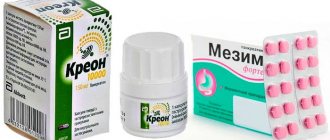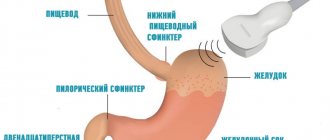Causes of bleeding in the intestines
There are several factors that can cause bleeding, they are:
- Specific.
- Non-specific.
Specific causes include:
- diseases of the digestive system with the appearance of ulcers and inflammation;
- polyps, tumors and malignant formations;
- traumatic damage to the mucous membrane;
- hemorrhoids, provided that they are internal in nature.
Causes of nonspecific intestinal bleeding include:
- Various disorders of the endocrine system.
- Nasal or pulmonary bleeding with reflux of biological fluid into the esophagus.
- Eating food that contains dyes that can change the color of the stool.
These reasons most often lead to the appearance of blood from the organs of the digestive system, but a similar phenomenon is also observed with syphilis or tuberculosis.
Diseases of the gastrointestinal tract are the main factor in the occurrence of internal bleeding. Ulcers and lesions that appear on the surface of the intestine begin to bleed profusely as stool passes, which leads to the development of a pathological condition.
Important:
Bleeding leads to the appearance of nonspecific symptoms if it is not profuse and occurs in a latent form.
Examples include ulcerative colitis or Crohn's disease. During the course of these diseases, multiple or single foci of erosion appear on the surface of the intestine.
Polyps and tumors, as well as malignant formations, are growths of connective, glandular or other tissue. As a result of natural processes of digestion, formation, tumors or polyps become damaged, hence the appearance of blood in the stool.
Injuries to the mucous membrane should be regarded as damage to the digestive organs; they can occur when a foreign body enters the stomach and intestines. Hemorrhoids are a disease of the rectum that occurs due to varicose veins.
During the course of the pathological process, venous nodes of various sizes are formed on the outside of the anus or inside the rectum. They can be injured by feces and bleed profusely.
Reasons for appearance
Internal bleeding occurs as a result of various reasons. Today, doctors identify more than 200 factors that lead to damage to the gastrointestinal tract and also provoke severe symptoms of the disorder.
Damage to the esophagus develops as a result of varicose veins localized in the area of the organ. Bleeding from the rectum in most cases occurs with hemorrhoids, anal fissures and injuries to the mucous membranes.
It is noted that most often the pathology develops in men aged 45-60 years, which is associated with the characteristics of professional activity and certain factors. Almost 50% of all cases of internal bleeding occur in the stomach, about 30% in the duodenum. The remainder of the cases occur in other parts of the digestive tract.
Among the most common causes of pathology, regardless of the form of the disorder, are the following:
- Acute and chronic gastritis.
- Ulcerative lesions of the mucous membrane of the stomach and duodenum. This reason is considered the most common.
- Erosive lesions of the intestines and esophagus.
- Constant stressful situations that lead to increased production of gastric juice and irritation of the mucous membrane of the digestive tract.
- Professional activity associated with constant night shifts and the inability to eat food in a timely manner.
- Abuse of fatty, fried, smoked and spicy foods, which negatively affect the condition of the digestive tract.
- Endocrine pathologies that are accompanied by dysfunction of the parathyroid glands.
- Chronic diseases of the liver and pancreas with regular exacerbations.
- Tumors localized in the stomach and intestines.
- Uncontrolled and frequent use of drugs from the group of non-steroidal anti-inflammatory drugs, which negatively affect the condition of the mucous membrane of organs.
Causes of internal bleeding of the gastrointestinal tract
These reasons can provoke damage to any part of the digestive tract, so doctors do not distinguish factors depending on the type of bleeding. Sometimes pathology develops as a result of one factor, more often as a result of a combination of several reasons.
Types of disease
Bleeding as a condition has a certain classification, it happens:
- pungent or copious;
- moderate;
- insignificant.
Abundant or acute is characterized by significant loss of blood, is active and requires emergency hospitalization of the patient.
Moderate blood loss over a short period of time may go unnoticed. But as soon as changes occur in a person’s condition, hospitalization will be required.
Minor blood losses are considered dangerous because they can go unnoticed for a long time. During this period, against the background of the condition, certain changes occur in the human body.
In case of heavy bleeding, the patient is immediately hospitalized, and in case of minor bleeding, treatment is carried out on an outpatient basis.
Diagnosis of the small intestine?
There are several methods for diagnosing the small intestine. In most cases, the first step is endoscopy and/or enteroscopy. If these methods fail to find the source of intestinal bleeding, the next step is capsule endoscopy. It is also possible to use radiological diagnostic methods, including barium x-ray or computed tomography (also known as) of the small intestine. Examination of the small intestine has also become possible thanks to the enteroscopy method - a special endoscope has areas with inflatable balls and/or external tubes that allow you to “pull up” further and further along the intestine. A last resort option, usually used only when other methods have failed, is intraoperative enteroscopy. All these methods will be discussed in detail below.
Signs, symptoms and first aid for intestinal bleeding
The disease has a number of characteristic symptoms, they depend on the type of condition and the disease that led to the loss of biological fluid.
What are the symptoms of internal bleeding in the intestines:
- Abdominal pain.
- General weakness.
- Paleness of the skin.
- Iron taste in mouth.
- Change in color of stool.
- Vomiting or diarrhea with blood.
Against the background of an infectious disease, in addition to blood in the stool, a person’s temperature rises and signs of intoxication appear in the body.
Weakness, pale skin, decreased blood pressure are signs of iron deficiency anemia, which develops with moderate and minor bleeding.
But if the loss of biological fluid is acute, there is a sharp pain in the abdomen, loss of consciousness, and a frequent urge to defecate with the release of blood clots and mucus.
Signs of bleeding in the intestines may increase, be hidden, and appear periodically. When collecting anamnesis, the patient recalls 2-3 cases when he noticed the appearance of red streaks in the stool and a change in its color.
What does the shade tell you?
The color of the stool can tell you what the nature of the bleeding is:
- if the stool changes color, becomes dark, liquid and the person complains of frequent urges, then blood loss is abundant;
- if there are clots of blood and mucus in the stool, the stool has a bright red or scarlet tint, then the bleeding is either moderate or profuse;
- if the feces have not changed color and only sometimes streaks resembling blood appear on their surface, then the loss of biological fluid is insignificant.
Based on the color of the feces, the doctor can determine in which part of the intestine the bleeding site is located:
- If the stool is dark, then the large intestine should be examined.
- If the stool has a brighter shade, it is the small intestine.
- If blood appears after emptying and resembles a scarlet trickle on the surface, then the cause of this phenomenon is considered to be hemorrhoids.
As a sign of the disease:
- intestinal tuberculosis: prolonged diarrhea mixed with blood, significant weight loss, general intoxication of the body;
- nonspecific inflammatory disease: damage to the eyes, skin lesions and joints;
- infections: increased body temperature, prolonged diarrhea mixed with mucus and blood;
- hemorrhoids and anal fissure: pain in the perineum, difficulty bowel movements, blood on toilet paper;
- oncological tumors: pain in the abdomen, profuse vomiting of blood, loss of appetite, deterioration in general health.
If the stool has changed color, and the act of defecation does not cause discomfort to the person, there is no pain and the state of health is normal, then the cause may be the foods consumed the day before. Fruits, berries and vegetables (blueberries, pomegranates, beets, etc.) can color stool.
How to stop intestinal bleeding
If blood loss is profuse, then at home it is necessary to provide the person with first aid:
- Lay it on a flat surface.
- Place ice or a bottle of cold water on the abdominal area.
- Call an ambulance.
What is not recommended to do:
- drink hot drinks;
- Eating;
- bathe in a hot bath.
It is prohibited to perform any physical activity that may cause an increase in blood pressure and increased bleeding.
When the medical team arrives, they will provide the patient with the following assistance:
- measure blood pressure levels;
- will administer hemostatic drugs intravenously.
Without special equipment, doctors will not be able to determine the cause of the pathological condition. For this reason, the person will be given an injection of a drug that will help reduce the rate of blood loss. After the injection, the patient will be placed on a stretcher and taken to the hospital.
Symptoms
The manifestations of the pathology largely depend on the degree of its neglect and accompanying complications.
The most common symptoms of the disease:
- Causeless and severe weakness, malaise, which persists even after a long rest. At the same time, the patient cannot understand the cause of the disorder and tries to lead a normal lifestyle.
- Dizziness and headache, which is associated with insufficient oxygen supply to the brain. When taking analgesics, the patient's condition does not improve, which is due to the lack of normal absorption of the drug in the digestive tract.
- Extreme thirst and complete lack of appetite. Even when trying to eat food, the patient feels nauseated.
- Fainting may develop, which is associated with a critical decrease in blood pressure.
- Increased heart rate and the appearance of droplets of cold sweat on the forehead.
- Some patients experience impaired consciousness, accompanied by lethargy or excessive excitability.
- Frequent vomiting and loose stools.
Among the external manifestations one can highlight pallor and dampness of the skin, blue lips and tips of the fingers and toes. The patient takes a forced position, that is, lies on his side with his knees pressed to the chest. In addition, the consistency and color of feces and vomit changes.
Vomiting occurs 3 to 6 times a day and is black in color. In medicine, this symptom is called “coffee grounds” vomiting. It is worth noting that if the color is black, we can talk about the average degree of neglect of the condition, but if there is scarlet blood in the vomit, most likely the patient’s esophageal mucosa is damaged.
Types of vomiting blood
The stool also becomes black in color and has a tarry, viscous consistency. Loose stools occur less often than vomiting, but the combination of these two manifestations leads to the development of dehydration, which significantly worsens the patient’s condition and can provoke other complications.
If your blood pressure changes, your doctor may note a gradual decrease as the condition progresses. The heart rate increases, which also worsens the course of the pathology.
It is worth noting that pain in the area of damage to the gastrointestinal tract is not always present . Some patients do not feel any discomfort. If the patient experiences pain when signs of bleeding appear, it is almost always relieved by vomiting.
Diagnostics
If pathological signs appear, you should contact:
- to a gastroenterologist;
- see an endocrinologist.
A consultation with a gastroenterologist will help establish the exact fact of the disease, but in addition to this specialist, you should also contact an endocrinologist. It will help determine whether the pathological condition is associated with metabolic disorders in the body.
First diagnostic procedures:
- You will need to donate blood for a clinical analysis in order to determine the concentration of red blood cells, nephrocytes, hemoglobin and hematocrit.
- As well as feces for the presence of hidden blood (coagulogram), the study is relevant in various branches of medicine, and is used in cardiology when making a diagnosis. Prescribed for myocardial infarction and bleeding of various etiologies.
During the examination, the gastroenterologist pays attention to:
- on the color of the patient’s skin;
- to heart rate.
The doctor should measure the blood pressure level and find out whether the person has previously lost consciousness.
A manual or palpation examination of the rectum is carried out to identify the presence of hemorrhoids in this area, which could have suffered significant damage, resulting in the appearance of blood.
Hemorrhoids are treated by a proctologist, not a gastroenterologist, so the doctor can redirect the patient to another specialist if the cause of the bleeding is varicose veins of the rectum.
What tests will help make a diagnosis:
- Endoscopy.
- Sigmoidoscopy.
- Colonoscopy.
An endoscopic examination is carried out by introducing special endoscope devices through natural pathways, with the help of which doctors are able to examine the mucous membrane of an organ under multiple magnification, identify the area that has undergone pathological changes and make a diagnosis for the patient.
Sigmoidoscopy is an examination performed using a special endoscope, which helps to identify the presence of foci of inflammation in the area of the colon and rectum. The endoscope is inserted through the anus, without the use of anesthesia.
Thus:
The information obtained is sufficient to determine the localization of the pathological process and identify changes in the mucous membrane. Sigmoidoscopy requires preliminary preparation.
Colonoscopy is a modern diagnostic method using an endoscope in the form of a thin tube with a microcamera at the end. The tube is inserted into the patient's anus, while air is supplied.
This allows you to smooth out the folds of the intestines. A fibrocolonoscope helps determine the condition of the mucous membrane of organs and detect sluggish bleeding. If a tumor or polyp is detected, collect material for a biopsy.
An endoscopic examination with the insertion of a probe helps not only to diagnose the patient, but also to carry out procedures to localize the source of bleeding. Using electrodes, cauterize the vessel or perform a polypectomy. Detect a blood clot in the organ cavity and determine its characteristics.
If the cause of blood loss cannot be determined, the following is prescribed:
- Mesentericography involves the introduction of labeled red blood cells into the mesenteric artery. After which the patient undergoes an x-ray. The picture shows the movement of specially colored bodies. The procedure allows us to identify characteristic architectural vascular features using contrast.
- Scintigraphy is a radioisotope diagnostic method. The procedure is very specific and involves introducing a radiopharmaceutical into the body and tracking and recording the radiation produced. Isotopes can be found in organs and tissues, which helps to identify pathological foci of inflammation and bleeding. The procedure helps to evaluate the work of a particular organ and identify deviations.
Mesentericography is effective only if blood loss is 0.5 ml per minute or more intense. If it is possible to detect a lesion, then doctors can use the previously inserted catheter to perform sclerotherapy.
If the bleeding intensity is lower, no more than 0.1 ml per minute, then scintigraphy is prescribed - the introduction of isotope-labeled red blood cells into the human body.
Why is this needed:
Intravenous administration of blood cells helps to detect the source of bleeding, but the examination cannot provide clear information about its location. As part of the diagnosis, the process of movement of red blood cells is monitored, this is done using a special camera.
Lastly, radiographic studies of the intestinal passage are carried out. In order for the examination to take place, the patient takes a barium suspension.
This is a contrast agent, the progress of which will be monitored using x-rays. The contrast will pass through the large and small intestines. And when the passage enters the cecum, the study is considered certified.
X-rays of the intestine may distort the results of other examinations performed using an endoscope. For this reason, the study is carried out last, and its results are assessed after the bleeding has stopped, no earlier than 48 hours.
Stomach bleeding
Gastric bleeding is the leakage of blood into the lumen of the stomach from damaged vessels. This pathological condition occupies a leading position among all causes of emergency hospitalization in surgical hospitals.
Source: cardio-life.ru
More than a hundred pathologies are known that can lead to the development of gastric bleeding. The most common of these is gastric ulcer - bleeding occurs in approximately 20% of patients with a history of gastric ulcer in the absence of adequate treatment.
In case of heavy gastric bleeding, hospitalization in the intensive care unit is required.
The stomach is a hollow muscular organ located between the esophagus and the duodenum. The function of the stomach is the accumulation of food mass, its mechanical and chemical processing, absorption of certain substances, and movement further along the digestive tract.
In addition, the stomach produces hormones and biologically active substances and performs protective and excretory functions. The volume of an empty stomach is approximately 0.5 liters; after eating, the stomach can stretch to 1–4 liters.
Treatment of intestinal bleeding
After transporting the patient to the hospital, procedures begin. If the loss of biological fluid is significant, then drip administration of plasma or blood is prescribed.
Volumes of transfusions:
- Plasma: 50-10 ml, less often 400 ml.
- Blood: 90-150 ml.
- If bleeding is heavy: 300-1000 ml.
In addition to drip transfusion, intramuscular injection of blood protein is used; the indication for such procedures is arterial hypertension. If blood pressure is high, blood transfusion by drip is not advisable.
General recommendations:
- the patient needs complete rest;
- compliance with bed rest.
The patient should remain in bed and not experience any emotional or physical stress that could worsen his condition.
It is also practiced to administer homeostatic drugs that can stop or slow down the loss of biological fluid:
- Atropine sulfate.
- Benzohexonium solution.
- Rutin, Vikasol.
Benzohexonium solution is administered only if the blood pressure level is not reduced; it helps to reduce intestinal motility, reduce vascular tone, and stop blood loss.
Important:
Along with medications, a person is given a hemostatic sponge, crushed into pieces, to swallow.
If blood pressure drops sharply, drugs are used to increase its level: Caffeine, Cordiamine. If the pressure is below 50 mm, then blood transfusion is suspended until the pressure level stabilizes.
Treatment methods
Traditional and non-traditional methods are used to treat the disease.
The choice depends on the form and severity of the condition.
First aid
If a person has all the symptoms of internal bleeding, he must be given first aid before the doctor arrives.
You should perform the following steps step by step:
- Place the patient on the bed.
- Place a cushion of clothing or a pillow under your feet so that your feet are higher than your head.
- Provide fresh air and loosen tight clothing.
- Apply a heating pad with ice or a bottle of cold water to the stomach area, after wrapping it in a thin cloth or towel.
- Give the patient a few ice cubes and ask them to swallow.
- Call a doctor.
It is strictly contraindicated to give any medications without a prescription from a specialist. This is due to the fact that an ordinary person who is not related to medicine will not be able to distinguish the symptoms of different types of bleeding and medications can only worsen the course of the disease.
Medications
After the patient is admitted to the surgical department, he is prescribed several medications to eliminate symptoms. The scheme may vary.
But in most cases the following drugs are used:
- Aminocaproic acid is a solution that has pronounced hemostatic properties, helps stop bleeding and prevent complications. It is considered a very effective remedy; it is administered intravenously using a dropper, 100 ml 2 times a day. The duration of the course is 5-10 days. The cost of the drug is from 50 rubles. for 100 ml.
- Dicynone is a hemostatic agent for intramuscular administration, helps to quickly cope with symptoms, and improves the patient’s condition. The solution is injected into the muscle 3 times a day, 2 ml. The course lasts from 7 to 14 days. The product is very effective, its cost is 50-80 rubles.
- Vikasol is another effective medication for stopping bleeding and replenishing vitamin K deficiency. The drug does not have a quick effect, but is almost always included in the course of therapy. The patient is administered 1 ml of medication 2 times a day, the course lasts 10 days. The price of the medicine is from 70 rubles.
- Tranexam is a very effective and fast-acting hemostatic drug that is administered intravenously at a dose of 5 ml per day. Helps quickly cope with the symptoms of the disease and prevents massive blood loss. Treatment lasts from 3 to 10 days depending on the severity of symptoms. The price of the product is from 30 rubles. per ampoule.
- Omeprazole is a proton pump inhibitor that is highly effective. The product helps reduce the production of hydrochloric acid, which irritates the walls of the digestive tract. The patient is administered 1 bottle of the drug per day after adding 200 ml of sodium chloride, the solution is administered intravenously for 10 days. The price of the product is from 50 rubles. per bottle
- Reopolyglucin is a highly effective solution for restoring water balance. It is administered to patients for 7 days after relief of acute symptoms, 200 ml per day using a dropper. The price of the medicine is from 130 rubles.
- Trisol is another drug that is effective and contains the necessary salts to restore water balance. The product is administered using a dropper, 200-400 ml per day. Course duration is up to 14 days. The price of the product is from 100 rubles.
- Glucose 5% with the addition of ascorbic acid is also considered an effective remedy for stopping bleeding. 6 ml of ascorbic acid is added to 200 ml of glucose, after which it is administered intravenously using a dropper. Repeat the procedure for 7-10 days in a row. The price of the product is from 30 rubles. for glucose and from 60 rub. for ascorbic acid.
In some cases, the patient is infused with fresh frozen plasma, which stimulates the restoration of the mucous membranes of the digestive tract. The dosage and duration of use of each medication may vary.
Traditional methods
Internal bleeding of the gastrointestinal tract (symptoms of pathology should not be ignored) cannot be cured using traditional methods. However, after acute symptoms are relieved, some medications speed up recovery.
Nettle decoction is considered a good hemostatic agent. You can prepare it from 20 g of dry herb and 500 ml of water, cook for 5 minutes, leave for at least 30 minutes. Take the filtered decoction 50 ml 2 times a day for 1 week.
A decoction based on oak bark has astringent properties and helps cope with the disease. For 1 liter of water, take 30 g of pre-crushed and dried bark and cook for 10 minutes. After 1 hour of infusion, filter the decoction, take 30 ml 3 times a day. The course of treatment is 10 days.
Any folk remedy can be used only after permission from a doctor. Self-medication can be very life-threatening for the patient.
Other methods
Among additional treatment methods, only surgical intervention can be distinguished, which is indicated in cases of severe pathology, lack of effect from conservative therapy and the development of complications.
The operation can be performed using an endoscope without damaging tissue. This allows you to cope with small lesions. In addition, bleeding can be stopped by cauterizing the vessels in the area of ulceration.
The injection method involves the introduction of hemostatic drugs around the lesion. The most dangerous and serious method is considered to be resection of a part of the organ in order to eliminate the lesion. It is performed under general anesthesia and involves eliminating the lesion followed by stitching the tissues together.
After the operation, the patient undergoes long-term rehabilitation, adheres to a diet and takes medications.
Surgery
Indications for emergency surgery:
- Ulcer. Provided that it is not possible to stop intestinal bleeding or a relapse of the condition occurs after stopping. The most effective procedures are those carried out in the first two days from the moment of contacting a medical institution.
- Cirrhosis of the liver. Provided that the disease is advanced and its treatment with conservative medicine has not led to the desired results.
- Thrombosis. In combination with acute abdominal syndrome.
- Tumors of oncological and other nature. Provided that the bleeding cannot be stopped.
If the cause of the bleeding cannot be determined, then the operation is performed urgently. During this procedure, the surgeon opens the abdominal cavity and tries to independently determine the cause of blood loss. If the lesion cannot be detected, then resection is performed - removal of part of the intestine.
There are other less traumatic methods of surgical treatment:
- Sclerosis is the introduction of a special substance into a bleeding, burst or damaged vessel, which “glues it together” and thereby stops the loss of biological fluid.
- Arterial embolism - ligation of it with special collagen or other rings, as a result of which the bleeding stops, since the blood flow to the organ is limited in a particular area.
- Electrocoagulation is the cauterization of a burst or damaged vessel with a hot electrode.
But if, during the opening of the abdominal cavity, the surgeon discovers a tumor or polyp, he cuts out the formation, and the resulting material is sent for histological examination. Further treatment of the patient will depend on the results of histology.
Possible complications
Lack of proper and timely treatment will certainly lead to complications.
The most common of them:
- Anemia.
- Development of a coma.
- Heart pathologies.
- Brain damage due to oxygen deficiency.
- Increase in the area of the lesion.
The most dangerous complication is considered to be death as a result of a critical decrease in blood pressure and lack of medical care.
Internal bleeding is considered a very dangerous lesion of the gastrointestinal tract, which can cause severe complications. Symptoms of pathology do not always indicate the true cause of the disorder, so it is important to consult a doctor at the first manifestations to undergo an examination and prescribe the correct treatment.
conclusions
Small bowel bleeding is a rare, often difficult to diagnose cause of gastrointestinal bleeding. Arteriovenous malformations account for 30 to 40% of cases, and are the main source of intestinal bleeding in patients over the age of 50. Other sources of intestinal bleeding include tumors (benign and malignant), polyps, Crohn's disease, ulcers and several others.
Various techniques are used to find and treat the source of bleeding in the small intestine, including:
- endoscopy,
- enteroscopy,
- x-ray research methods,
- capsule endoscopy,
- deep enteroscopy of the small intestine
- intraoperative enteroscopy.
Arteriovenous malformations are usually treated by cauterization using a special probe passed through the channel of an endoscope or enteroscope. Tumors (benign and malignant) can be sampled using biopsy forceps and have their location marked with an injection of a special compound using an endoscope. But their removal usually requires surgery. Other diseases of the small intestine, such as Crohn's disease, are often treated with medications.
The key factor in the treatment of intestinal diseases is the experience of the specialist conducting the study. It is important to find a good gastroenterologist and endoscopist and follow all their recommendations. If you have even the slightest suspicion of intestinal bleeding, consult a doctor immediately, as any delay is life-threatening.
What is capsule endoscopy?
In 2000, a group of doctors in England reported using a new tool to determine the causes of intestinal bleeding in the small intestine. This device was called an endoscopic capsule and measures 26 mm x 11 mm - the size of a large pill.
It consists of a battery with an 8-hour lifespan, a strong light source, a camera and a small transmitter. Once swallowed, the capsule begins to transmit images of the inside of the esophagus, stomach and small intestine to a receiver worn by the patient. The capsule takes two pictures per second, for a total of about 55,000 images per session. After 8 hours, the patient returns the receiver to the doctor, who downloads the information onto a computer and then reviews each bowel image taken in detail, looking for abnormalities that are possible sources of bleeding. The capsule continues its path through the patient’s colon and is excreted naturally.
The given technical parameters may differ for different capsule endoscopy systems. There are video capsules that work longer than 8 hours and shoot more than 2 frames per second.
Swallowing the capsule is fairly easy and safe; however, the capsule may become stuck in the small intestine. Video capsule delay may occur in the following cases:
- if the patient has previously undergone abdominal surgery that caused scarring in the intestines
- patients have a pathology in the intestine that has led to a severe narrowing of its lumen.
If the capsule gets stuck, it will need to be removed endoscopically or surgically. The positive point is that capsule retention almost never leads to acute obstruction, and the site of retention is directly adjacent to the pathological focus. In this case, along with the extraction of the capsule, therapeutic measures are taken to remove the pathology found.
In 15% of cases, the capsule does not have time to pass through the entire small intestine and photograph its mucous membrane because its battery runs out, in which case the study may have to be repeated. This phenomenon is more typical for video capsules with an operating time of 8 hours. For video capsules with 12 hours of operation, the likelihood of incomplete examination of the small intestine is significantly lower.
Like X-rays, the video capsule is a purely diagnostic method and cannot be used to take a biopsy, carry out treatment, or perform tattooing for subsequent surgical treatment. In addition, the capsule cannot be controlled. Therefore, the doctor does not have the opportunity to return to the suspicious area and examine it in more detail. Despite these limitations, capsule endoscopy is the gold standard for searching for occult intestinal bleeding in the small intestine (occult is intestinal bleeding that cannot be detected by standard endoscopic methods, but all symptoms of bleeding are present).
Popular publications:
- Video capsule endoscopy: frequently asked questions - 11/12/2013 17:02 - Read 42683 times
- Black feces Why? Causes? — 01/07/2015 05:06 — Read 42448 times
- Capsule endoscopy. Description, reviews, advantages and disadvantages - 03/24/2013 17:15 - Read 39070 times
- Abdominal syndrome. Abdominal pain - 01/10/2015 05:02 - Read 22218 times
- Capsule colonoscopy - indications, contraindications, price - 30/10/2015 07:20 - Read 17295 times
Key words: Small bowel bleeding, small bowel bleeding, capsule endoscopy, endoscopy, enteroscopy
- < Back
- Forward >










